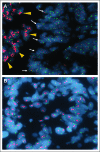Adverse prognostic impact of intratumor heterogeneous HER2 gene amplification in patients with esophageal adenocarcinoma
- PMID: 22987085
- PMCID: PMC3675687
- DOI: 10.1200/JCO.2012.43.1890
Adverse prognostic impact of intratumor heterogeneous HER2 gene amplification in patients with esophageal adenocarcinoma
Abstract
Purpose: There is increasing recognition of the existence of intratumoral heterogeneity of the human epidermal growth factor receptor (HER2), which affects interpretation of HER2 positivity in clinical practice and may have implications for patient prognosis and treatment. We determined the frequency and prognostic impact of heterogeneous HER2 gene amplification and polysomy 17 in patients with esophageal adenocarcinoma (EAC).
Patients and methods: HER2 amplification (by fluorescence in situ hybridization) was examined in surgical EAC specimens (n = 675). HER2 heterogeneity was defined according to consensus guidelines as gene amplification (HER2/CEP17 ratio ≥ 2.0) in more than 5% but less than 50% of cancer cells. No patient received neoadjuvant or HER2-targeted therapy. Cox models were used to assess disease-specific survival (DSS) and overall survival (OS).
Results: Overall, 117 EACs (17%) demonstrated HER2 amplification, of which 20 (17%) showed HER2 heterogeneity. All HER2-heterogeneous tumors were amplified. Among HER2-amplified tumors, heterogeneous tumors had significantly higher frequency of poor histologic grade and polysomy 17. In multivariable models that included number of metastatic lymph nodes, grade, tumor stage, and polysomy 17, only HER2 heterogeneity and node number were prognostic among HER2-amplified tumors, with heterogeneity showing worse DSS (hazard ratio, 2.04; 95% CI, 1.09 to 3.79; P = .025) and OS (P = .026). Among HER2-nonamplified EACs, polysomy 17 was independently associated with worse DSS (P = .012) and OS (P = .023).
Conclusion: Among HER2-amplified EACs, 17% show HER2 heterogeneity, which independently predicts for worse cancer-specific death. Among HER2-nonamplified EACs, polysomy 17 is independently associated with worse survival. These novel findings demonstrate aggressive subgroups in HER2-amplified and -nonamplified EACs that have important implications for HER2 analysis and determination of benefit from HER2-targeted therapy.
Conflict of interest statement
Authors' disclosures of potential conflicts of interest and author contributions are found at the end of this article.
Figures



Similar articles
-
HER2/neu (ERBB2) expression and gene amplification correlates with better survival in esophageal adenocarcinoma.BMC Cancer. 2019 Jan 8;19(1):38. doi: 10.1186/s12885-018-5242-4. BMC Cancer. 2019. PMID: 30621632 Free PMC article.
-
Association of HER2/ErbB2 expression and gene amplification with pathologic features and prognosis in esophageal adenocarcinomas.Clin Cancer Res. 2012 Jan 15;18(2):546-54. doi: 10.1158/1078-0432.CCR-11-2272. Clin Cancer Res. 2012. PMID: 22252257 Free PMC article.
-
HER-2/neu gene amplification in relation to expression of HER2 and HER3 proteins in patients with esophageal adenocarcinoma.Cancer. 2014 Feb 1;120(3):415-24. doi: 10.1002/cncr.28435. Epub 2013 Oct 21. Cancer. 2014. PMID: 24151090 Free PMC article.
-
HER2 in situ hybridization in breast cancer: clinical implications of polysomy 17 and genetic heterogeneity.Mod Pathol. 2014 Jan;27(1):4-18. doi: 10.1038/modpathol.2013.103. Epub 2013 Jun 28. Mod Pathol. 2014. PMID: 23807776 Review.
-
HER2 Intratumoral Heterogeneity in Breast Cancer, an Evolving Concept.Cancers (Basel). 2023 May 9;15(10):2664. doi: 10.3390/cancers15102664. Cancers (Basel). 2023. PMID: 37345001 Free PMC article. Review.
Cited by
-
HER2/neu (ERBB2) expression and gene amplification correlates with better survival in esophageal adenocarcinoma.BMC Cancer. 2019 Jan 8;19(1):38. doi: 10.1186/s12885-018-5242-4. BMC Cancer. 2019. PMID: 30621632 Free PMC article.
-
Multi-colour FISH in oesophageal adenocarcinoma-predictors of prognosis independent of stage and grade.Br J Cancer. 2014 Jun 10;110(12):2985-95. doi: 10.1038/bjc.2014.238. Epub 2014 May 22. Br J Cancer. 2014. PMID: 24853183 Free PMC article.
-
Gastric biomarkers: a global review.World J Surg Oncol. 2016 Aug 11;14(1):212. doi: 10.1186/s12957-016-0969-3. World J Surg Oncol. 2016. PMID: 27514667 Free PMC article. Review.
-
Clinical significance of the expression of EGFR signaling pathway-related proteins in esophageal squamous cell carcinoma.Tumour Biol. 2014 Jan;35(1):651-7. doi: 10.1007/s13277-013-1089-0. Epub 2013 Sep 20. Tumour Biol. 2014. PMID: 24052437
-
Histological intratumoral heterogeneity in pretreatment esophageal cancer biopsies predicts survival benefit from neoadjuvant chemotherapy: results from the UK MRC OE02 trial.Dis Esophagus. 2020 Aug 3;33(8):doaa058. doi: 10.1093/dote/doaa058. Dis Esophagus. 2020. PMID: 32591823 Free PMC article.
References
-
- Pohl H, Welch HG. The role of overdiagnosis and reclassification in the marked increase of esophageal adenocarcinoma incidence. J Natl Cancer Inst. 2005;97:142–146. - PubMed
-
- Enzinger PC, Mayer RJ. Esophageal cancer. N Engl J Med. 2003;349:2241–2252. - PubMed
-
- Jemal A, Siegel R, Xu J, et al. Cancer statistics, 2010. CA Cancer J Clin. 2010;60:277–300. - PubMed
-
- Bang YJ, Van Cutsem E, Feyereislova A, et al. Trastuzumab in combination with chemotherapy versus chemotherapy alone for treatment of HER2-positive advanced gastric or gastro-oesophageal junction cancer (ToGA): A phase 3, open-label, randomised controlled trial. Lancet. 2010;376:687–697. - PubMed
Publication types
MeSH terms
Substances
Grants and funding
LinkOut - more resources
Full Text Sources
Other Literature Sources
Medical
Research Materials
Miscellaneous

